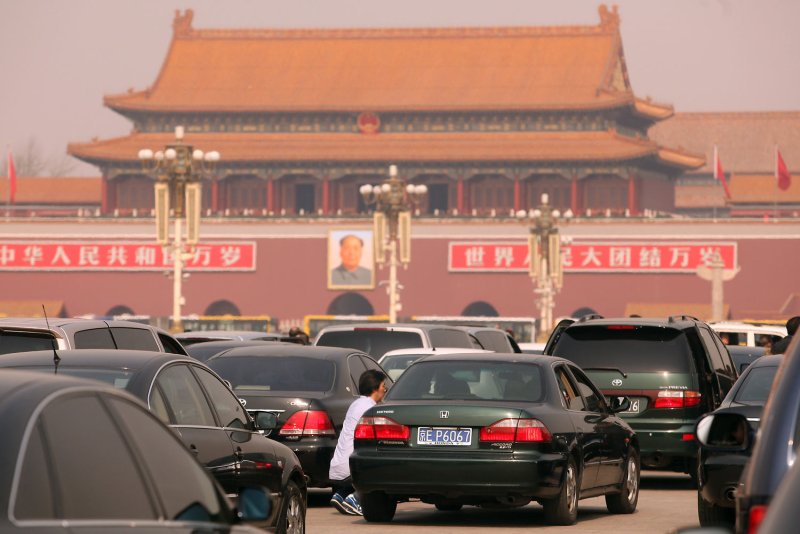A traffic jam develops on Tiananmen Square. Saudi Arabia sells more oil to China and than it does to the United States. UPI/Stephen Shaver |
License Photo
BEIRUT, Lebanon, Sept. 16 (UPI) -- China's drive to secure Middle Eastern oil supplies is likely to find Beijing in competition with the United States, which despite efforts to wean itself off Persian Gulf crude is likely to return to the region as reserves in Canada and Mexico dwindle, analysts say.
The Middle East, mainly the gulf, contains more than half the world's proven reserves of oil.
The United States gets around one-eighth of its imported oil from the region. But, says Yitzhak Shichor, a China expert with Israel's Haifa University, that volume is growing as Canadian and Mexican reserves shrink.
"I think sooner or later the U.S. will come back to the Middle East," he told the Media Line, a Middle Eastern news outlet.
"Oil from Canada and Mexico will diminish … which means China, the U.S. and India will have to coordinate purchases … The alternative is competition or confrontation."
The potential for Chinese-U.S. rivalry is being heightened by a major naval buildup by Beijing. Its first aircraft carrier, a refurbished former Soviet vessel named the Shi Lang, underwent its first sea trials in July.
Western defense experts say China plans to build at least four carriers for long-distance power projection in strategic areas, including the Middle East.
China's recent deployment of warships in the Gulf of Aden with the declared mission of combating Somalia pirates is widely seen as masking Beijing's unfolding strategy of protecting its oil routes from the Persian Gulf and Africa.
The Americans have for many years considered the Horn of Africa, south of the Gulf of Aden, as part of the wider Middle East, which explains why it was placed under the charge of the U.S. Central Command that covers the Middle East.
Since 1998 it's been considered an operational zone for al-Qaida. On the Chinese side, corporations dominated by the People's Liberation Army, like Norinco, have sold arms across the region in return for access to oil and other resources since the 1970s.
As China's navy rapidly expands, the three-ship Chinese flotilla in the Gulf of Aden is likely be supplanted by larger naval formations that will extend to the Mediterranean and oil-rich Algeria and Libya as well.
Indeed, a Chinese warship entered the Mediterranean shortly after Libya's civil war began in February to cover the evacuation of thousands of Chinese working for Chinese oil companies there.
The Americans see China, with its mushrooming economic development, as a future rival in the Pacific theater.
But the indications are that this will also manifest itself in the greater Middle East over the next few years and most likely along the shipping lanes across the Indian Ocean that make up China's lifeline.
"While China and the United States are not engaged in overt competition in the Middle East, it is not difficult to envision that the region could emerge as the stage for future Sino-U.S. rivalry," observed Hong Kong energy analyst Chietigj Bajpaee.
"Not only are the U.S. and China dependent on energy resources from the Middle East, but both states offer competing models for international conduct, with the Chinese model becoming increasingly popular in the region."
Bajpaee noted that Middle Eastern regimes traditionally tied to the United States have been opening up to with China since 9/11 and the downturn in U.S. power in the region.
That's likely to widen as a result of the political upheaval in the Arab world since January.
These days, Saudi Arabia, which sits on 20 percent of the planet's known oil reserves, sells more oil to China and the Far East than it does to the United States.
Beijing buys 1-10th of the Persian Gulf's output and one-quarter of Iran's.
The International Energy Agency estimates that China's oil consumption will hit 13 million barrels per day by 2030, compared to 3.5 million bpd in 2006. Around half of that will come from the Middle East.
Resource rivalry between the United States and China is still relatively in its infancy. China has long been content to let the Americans bear the burden of protecting global oil supplies.
But as U.S. clout in the Middle East recedes, spurred by the debacles in Iraq and Afghanistan and by the Arab Spring, China may find it will have to step in. That could be messy.















